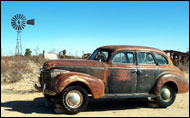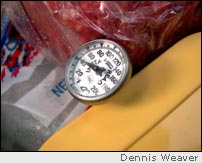Getting
Out There: |
Directory of all "Getting Out There" Articles> |
How to Make a "Speed Run" by Mark Sedenquist and Judy Carter
|
Continued from Page 1
GET SET
Packing
Give your road-trip vehicle a good examination and make sure the spare tire has the correct air pressure. Ensure that your road-trip supplies, tools and gear are complete, up to date and in working order. I keep a set of road-trip equipment and supplies in my vehicle at all times, making preparation for speed runs much less time-consuming. Here is a link to Judy's rather amazing list of on-board supplies.
Sleep
In the 48-hour period before a speed run, I try to get one to two extra hours of sleep each night so I can begin the trip fully rested. Anyone can do a single day of driving 750 miles or more, but the cumulative effect of long-haul driving over several days is extreme fatigue, which can be both dangerous and lead to crankiness, which is unpleasant for anyone traveling with you.
|
|
Road Food
Speed runs and restaurant meals don't mix. The portions are often too large, too high in calories and they take too much time to eat. I've found that eating a nutritious restaurant breakfast is a good way to start the day; I follow it with two or three other meals from my onboard cooler. Eating this way is healthier, and it saves time, too. Also drink plenty of water during the speed run - twice as much as usual. Staying hydrated not only curbs hunger, it increases alertness. An added benefit is that it forces you to stop for quick breaks frequently.
GO!
Three-person Rotation
If you are traveling with other drivers on a speed run, the optimal way to apportion the driving is by a three-person rotation. With three drivers, it's possible to drive continuously except for fuel, food and restroom breaks. In the rotation I like best, one driver drives for three hours, and then does a three-hour shift as the navigator-conversationalist in the front right seat. Then the navigator moves to the back seat and goes to sleep. This requires discipline. Some team drivers suggest that at the end of a driving shift, the driver immediately go to sleep. In my experience, it's better for the driver to unwind for a shift as the navigator, because it can be difficult to fall asleep right away.
Drive with the Sun
Driving toward either a setting or rising sun causes eye fatigue. Plan to have breakfast or take a MOVE break when the sun is near the horizon.
MOVE Breaks
In addition to eye fatigue, driving long distances can also cause leg cramps, decreased situational awareness and even a potentially life-ending medical condition known as deep venous thrombosis (DVT). The best prevention is very simple: Get out of the car and MOVE. When you stop for fuel or food, do some stretches, jog in place, chase a Frisbee or do your interpretation of the Chicken Dance. Forget about how odd you look - no one knows you! Do whatever it takes to get your circulation moving.
One Last Tip
When you get to your destination, relax and take time to recharge your batteries. It may seem like you've just been sitting in a car for a few days, but as anyone who has ever done it can tell you, long-distance driving under time pressure is exhausting and stressful.
We don't recommend speed runs,
but these tips will help ensure safety and success when moseying
is out of the question.
Mark Sedenquist and Judy Carter
September 17, 2006


